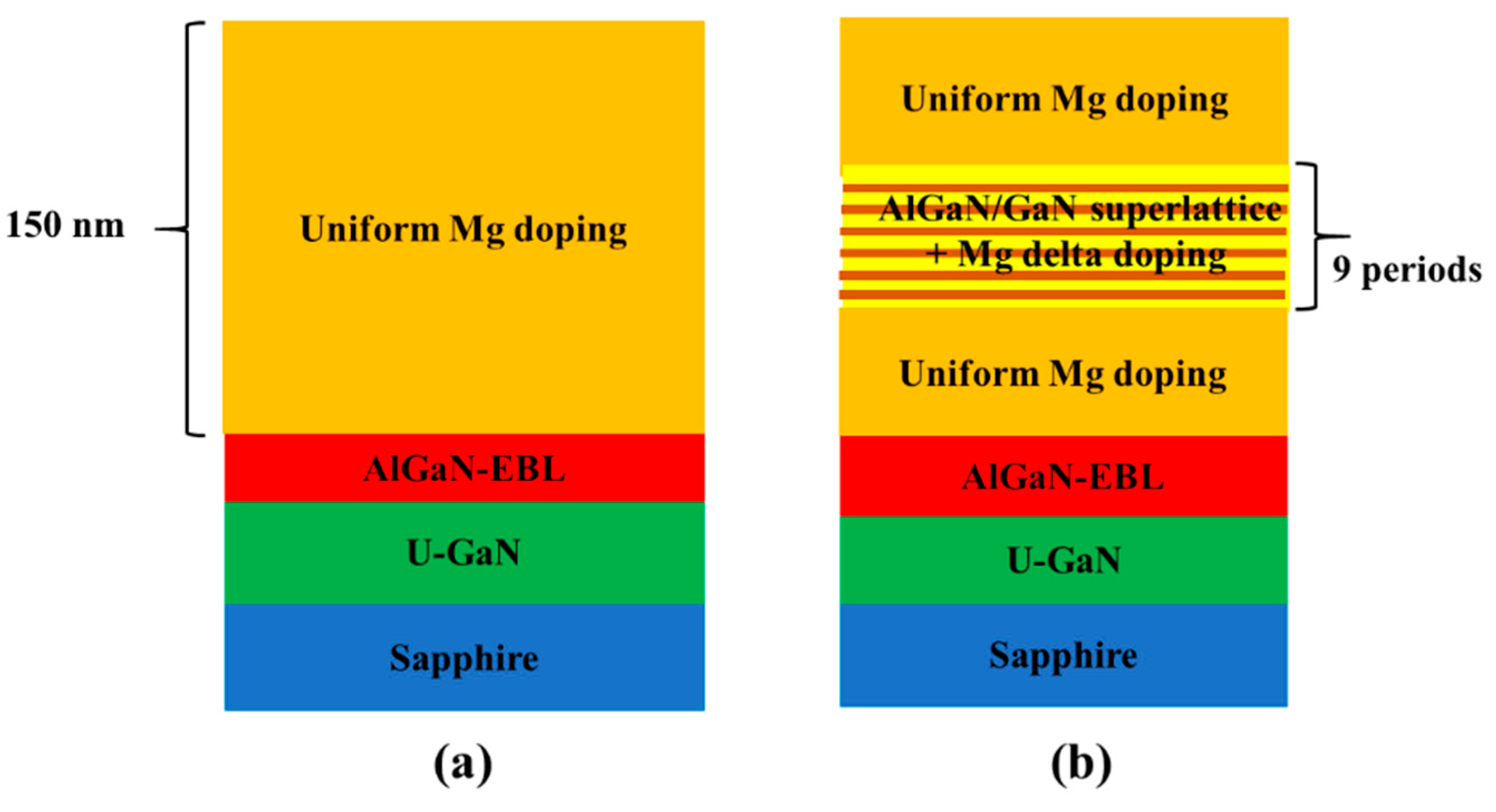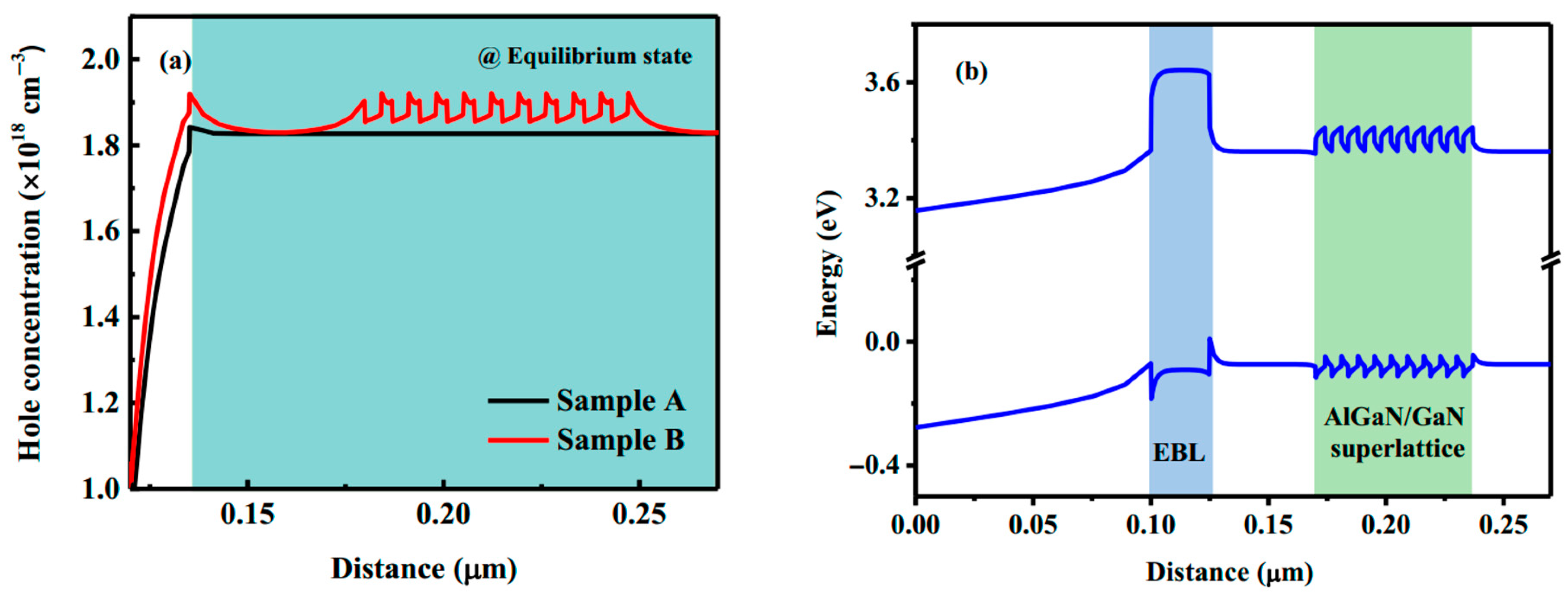Enhanced P-Type GaN Conductivity by Mg Delta Doped AlGaN/GaN Superlattice Structure
Abstract
1. Introduction
2. Materials and Methods
3. Results and Discussions
4. Conclusions
Author Contributions
Funding
Informed Consent Statement
Conflicts of Interest
References
- Peng, R.S.; Meng, X.J.; Xu, S.R.; Zhang, J.C.; Li, P.X.; Huang, J.; Du, J.J.; Zhao, Y.; Fan, X.M.; Hao, Y. Study on Dislocation Annihilation Mechanism of the High-Quality GaN Grown on Sputtered AlN/PSS and Its Application in Green Light-Emitting Diodes. IEEE Trans. Electron. Devices 2019, 66, 2243–2248. [Google Scholar] [CrossRef]
- Tao, H.C.; Xu, S.R.; Zhang, J.C.; Li, P.X.; Lin, Z.Y.; Hao, Y. Numerical Investigation on the Enhanced Performance of N-Polar AlGaN-Based Ultraviolet Light-Emitting Diodes with Superlattice p-Type Doping. IEEE Trans. Electron. Devices 2019, 66, 478–484. [Google Scholar] [CrossRef]
- Islam, A.M.H.; Shim, J.I.; Shin, D.S. Optoelectronic Performance Variations in InGaN/GaN Multiple-Quantum-Well Light-Emitting Diodes: Effects of Potential Fluctuation. Materials 2018, 11, 743. [Google Scholar] [CrossRef] [PubMed]
- Peng, R.S.; Xu, S.R.; Zhang, J.F.; Zhang, J.C.; Du, J.J.; Zhao, Y.; Fan, X.M.; Hao, Y. Influence of stress on the optical properties of double InGaN/GaN multiple quantum wells. Opt. Mater. Express 2018, 8, 1528. [Google Scholar] [CrossRef]
- Li, Y.C.; Chang, L.B.; Chen, H.J.; Yen, C.Y.; Pan, K.W.; Huang, B.R.; Kuo, W.Y.; Chow, L.; Zhou, D.; Popko, E. Phosphor-Free InGaN White Light Emitting Diodes Using Flip-Chip Technology. Materials 2017, 10, 432. [Google Scholar] [CrossRef] [PubMed]
- Yoo, H.; Ha, K.; Baek, J.Y.; Jung, M.S.; Su, P.C.; Kim, Y.; Cheon, S.; Cho, S.; Kim, K.K. Enhanced light extraction efficiency of GaN-based LED fabricated by multi-chip array. Opt. Mater. Express 2015, 5, 1098. [Google Scholar] [CrossRef]
- Fu, Y.; Sun, J.; Du, Z.F.; Guo, W.L.; Yan, C.L.; Xiong, F.Z.; Wang, L.; Dong, Y.B.; Xu, C.; Deng, J.; et al. 2 Monolithic Integrated Device of GaN Micro-LED with Graphene Transparent Electrode and Graphene Active-Matrix Driving Transistor. Materials 2019, 12, 428. [Google Scholar] [CrossRef]
- Tao, X.X.; Liu, J.L.; Zhang, J.L.; Mo, C.L.; Xu, L.Q.; Ding, J.; Wang, G.X.; Wang, X.L.; Wu, X.M.; Quan, Z.J.; et al. Performance enhancement of yellow InGaN-based multiple-quantum-well light-emitting diodes grown on Si substrates by optimizing the InGaN/GaN superlattice interlayer. Opt. Mater. Express 2018, 8, 1221. [Google Scholar] [CrossRef]
- Hwang, J.I.; Hashimoto, R.; Saito, S.; Nunoue, S. Development of InGaN-based red LED grown on (0001) polar surface. Appl. Phys. Express 2014, 7, 071003. [Google Scholar] [CrossRef]
- Simon, J.; Protasenko, V.; Lian, C.X.; Xing, H.L.; Jena, D. Polarization-Induced Hole Doping in Wide-Band-Gap Uniaxial Semiconductor Heterostructures. Science 2010, 327, 5961. [Google Scholar] [CrossRef]
- Amano, H.; Akasaki, I.; Kozawa, T.; Hiramatsu, K.; Sawaki, N.; Ikeda, K.; Ishii, Y. Electron beam effects on blue luminescence of zinc-doped GaN. J. Lumin. 1988, 40, 121–122. [Google Scholar] [CrossRef]
- Nakamura, S.; Mukai, T.; Senoh, M.; Iwasa, N. Thermal Annealing Effects on P-Type Mg-Doped GaN Films. Jpn. J. Appl. Phys. 1992, 31, L139–L142. [Google Scholar] [CrossRef]
- Kozodoy, P.; Smorchkova, Y.P.; Hansen, M.; Xing, H.L.; DenBaars, S.P.; Mishra, U.K.; Saxler, A.W.; Perrin, R.; Mitchel, W.C. Polarization-enhanced Mg doping of AlGaN/GaN superlattices. Appl. Phys. Lett. 1999, 75, 2444–2446. [Google Scholar] [CrossRef]
- Bayram, C.; Pau, J.L.; McClintock, R.; Razeghi, M. Delta-doping optimization for high quality p-type GaN. J. Appl. Phys. 2008, 104, 083512. [Google Scholar] [CrossRef]
- Suski, T.; Litwin-Staszewska, E.; Piotrzkowski, R.; Czernecki, R.; Krysko, M.; Grzanka, S.; Nowak, G.; Franssen, G.; Dmowski, L.H.; Leszczynski, M.; et al. Substrate misorientation induced strong increase in the hole concentration in Mg doped GaN grown by metalorganic vapor phase epitaxy. Appl. Phys. Lett. 2008, 93, 172117. [Google Scholar] [CrossRef]
- Korotkov, R.Y.; Gregie, J.M.; Wessels, B.W. Electrical properties of p-type GaN: Mg codoped with oxygen. Appl. Phys. Lett. 2001, 78, 222–224. [Google Scholar] [CrossRef]
- Chen, Y.D.; Wu, H.L.; Han, E.Z.; Yue, G.L.; Chen, Z.M.; Wu, Z.S.; Wang, G.; Jiang, H. High hole concentration in p-type AlGaN by indium-surfactant-assisted Mg-delta doping. Appl. Phys. Lett. 2015, 106, 162102. [Google Scholar] [CrossRef]
- Kwon, M.K.; Park, I.K.; Kim, J.Y.; Kim, J.O.; Kim, B.; Park, S.J. Gradient doping of Mg in p-type GaN for high efficiency InGaN-GaN ultraviolet light-emitting diode. IEEE Photonics Technol. Lett. 2007, 19, 1880–1882. [Google Scholar] [CrossRef]
- Zhang, Z.H.; Chen, S.W.H.; Chu, C.S.; Tian, K.K.; Fang, M.Q.; Zhang, Y.H.; Bi, W.G.; Kuo, H.C. Nearly Efficiency-Droop-Free AlGaN-Based Ultraviolet Light-Emitting Diodes with a Specifically Designed Superlattice p-Type Electron Blocking Layer for High Mg Doping Efficiency. Nanoscale Res. Lett. 2018, 13, 122. [Google Scholar] [CrossRef]
- Wang, H.B.; Liu, J.P.; Niu, N.H.; Shen, G.D.; Zhang, S.M. Enhanced performance of p-GaN by Mg delta doping. J. Cryst. Growth 2007, 304, 7–10. [Google Scholar] [CrossRef]
- Lai, M.J.; Jeng, M.J.; Chang, L.B. High-Efficiency InGaN-Based Yellow-Green Light-Emitting Diodes. Jpn. J. Appl. Phys. 2010, 49, 021004. [Google Scholar] [CrossRef]
- Saito, S.; Hashimoto, R.; Hwang, J.; Nunoue, S. InGaN Light-Emitting Diodes on c-Face Sapphire Substrates in Green Gap Spectral Range. Appl. Phys. Express 2013, 6, 111004. [Google Scholar] [CrossRef]
- Du, C.H.; Ma, Z.G.; Zhou, J.M.; Lu, T.P.; Jiang, Y.; Zuo, P.; Jia, H.Q.; Chen, H. Enhancing the quantum efficiency of InGaN yellow-green light-emitting diodes by growth interruption. Appl. Phys. Lett. 2014, 105, 071108. [Google Scholar] [CrossRef]
- Goepfert, I.D.; Schubert, E.F.; Osinsky, A.; Norris, P.E.; Faleev, N.N. Experimental and theoretical study of acceptor activation and transport properties in p-type AlxGa1-xN/GaN superlattices. J. Appl. Phys. 2000, 88, 2030–2038. [Google Scholar] [CrossRef]






| p-GaN | Hole Concentration (×1018 cm−3) | Mobility (cm2/V·s) | Sheet Resistivity (Ω/□) |
|---|---|---|---|
| Sample A | 1.5 | 10.0 | 34,407 |
| Sample B | 3.1 | 7.5 | 17,951 |
Publisher’s Note: MDPI stays neutral with regard to jurisdictional claims in published maps and institutional affiliations. |
© 2020 by the authors. Licensee MDPI, Basel, Switzerland. This article is an open access article distributed under the terms and conditions of the Creative Commons Attribution (CC BY) license (http://creativecommons.org/licenses/by/4.0/).
Share and Cite
Zhao, Y.; Xu, S.; Tao, H.; Zhang, Y.; Zhang, C.; Feng, L.; Peng, R.; Fan, X.; Du, J.; Zhang, J.; et al. Enhanced P-Type GaN Conductivity by Mg Delta Doped AlGaN/GaN Superlattice Structure. Materials 2021, 14, 144. https://doi.org/10.3390/ma14010144
Zhao Y, Xu S, Tao H, Zhang Y, Zhang C, Feng L, Peng R, Fan X, Du J, Zhang J, et al. Enhanced P-Type GaN Conductivity by Mg Delta Doped AlGaN/GaN Superlattice Structure. Materials. 2021; 14(1):144. https://doi.org/10.3390/ma14010144
Chicago/Turabian StyleZhao, Ying, Shengrui Xu, Hongchang Tao, Yachao Zhang, Chunfu Zhang, Lansheng Feng, Ruoshi Peng, Xiaomeng Fan, Jinjuan Du, Jincheng Zhang, and et al. 2021. "Enhanced P-Type GaN Conductivity by Mg Delta Doped AlGaN/GaN Superlattice Structure" Materials 14, no. 1: 144. https://doi.org/10.3390/ma14010144
APA StyleZhao, Y., Xu, S., Tao, H., Zhang, Y., Zhang, C., Feng, L., Peng, R., Fan, X., Du, J., Zhang, J., & Hao, Y. (2021). Enhanced P-Type GaN Conductivity by Mg Delta Doped AlGaN/GaN Superlattice Structure. Materials, 14(1), 144. https://doi.org/10.3390/ma14010144






